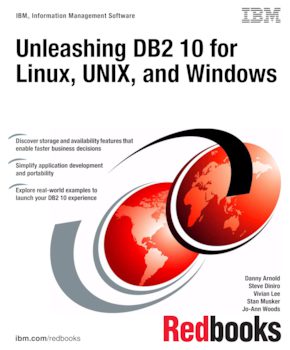
Published on 31 August 2012, updated 19 December 2012
Order hardcopy
Share this page:
ISBN-10: 0738437107
ISBN-13: 9780738437101
IBM Form #: SG24-8032-00
Authors: Danny Arnold, Steve Diniro, Vivian Lee, Stan Musker and Jo-Ann Woods
Abstract
This IBM® Redbooks® publication provides a broad understanding of the key features in IBM DB2® 10 and how to use these features to get more value from business applications. It includes information about the following features:
- Time Travel Query, which you use to store and retrieve time-based data by using capability built into DB2 10, without needing to build your own solution
- Adaptive compression, an enhanced compression technology that adapts to changing data patterns, yielding extremely high compression ratios
- Multi-temperature storage, which you may use to optimize storage costs by identifying and managing data based on its “temperature” or access requirements
- Row and column access control, which offers security access enforcement on your data, at the row or column level, or both
- Availability enhancements, which provide different DB2 availability features for different enterprise needs; high availability disaster recovery (HADR) multiple-standby databases provide availability and data recovery in one technology, and the IBM DB2 pureScale® Feature provides continuous availability and scalability that is transparent to applications
- Oracle compatibility, which allows many applications written for Oracle to run on DB2, virtually unchanged
- Ingest utility, a feature-rich data movement utility that allows queries to run concurrently with minimal impact on data availability
This book is for database administrators and application developers who are considering DB2 10 for a new installation, an upgrade from a previous version of DB2, or a migration from a vendor product. It explains key features and illustrates concepts with real-world examples to provide a clear idea of how powerful these features are.
Together, these features provide functionality that lower operational costs, ease development, and provide greater reliability.
Table of Contents
Chapter 1. Introduction to DB2 10
Chapter 2. Time Travel Query
Chapter 3. Adaptive compression
Chapter 4. Multi-temperature storage
Chapter 5. Row and column access control
Chapter 6. Availability enhancements
Chapter 7. Oracle compatibility
Chapter 8. Ingest utility
Appendix A. Ingest utility script